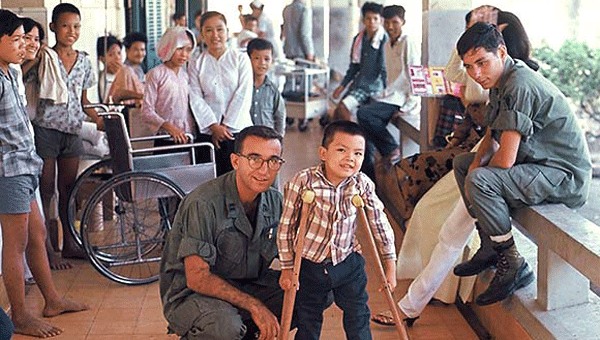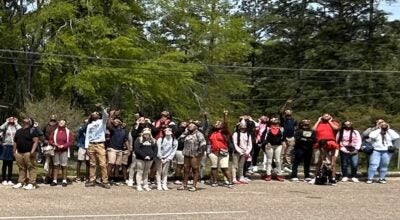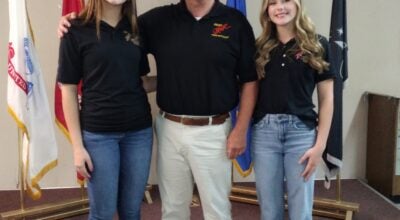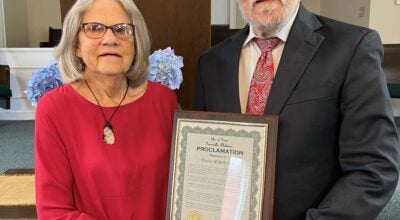Kushner recounts harrowing Vietnam stories in new book
Published 5:30 pm Friday, October 20, 2017

- Dr. Sheldon Kushner, left, is pictured with one of his favorite patients, a Vietnamese boy named Loc, in 1968. Kushner recently published a book detailing his year in Vietnam, called “Trauma and Tenacity in Vietnam: A Surgeon’s Story. (Submitted photo)
Dr. Sheldon Kushner saw an endless cycle of broken, shattered bones and broken, shattered people during his yearlong tour in Vietnam.
With the aid of Mary Jane Ingui and roughly 350 letters written to his wife during his time in Vietnam, Kushner spent the better part of six years turning those memories and photographs into physical form.
It ultimately manifested as “Trauma and Tenacity in Vietnam: A Surgeon’s Story,” a book detailing Kushner’s harrowing experiences in Vietnam, including both the inhumanity of war and the humanity displayed by those impacted by it.
The U.S. Air Force captain once spent 18 months working at a Greenville clinic, but before that he was unceremoniously thrust into the role of surgeon in the city of Vinh Long, located south of Vietnam’s capital, Saigon, along the Mekong River.
With visions of an easy tour ahead, complete with occasional bouts of golf and tennis, the then-26-year-old Kushner thought that the tour would be “a piece of cake” until a very somber speech prior to takeoff on the flight to Vietnam.
“A minister said a prayer before we took off, and he said ‘everybody needs to look at the man to your left and right. One of you won’t be coming back,’” he said.
“That’s when I tough this isn’t exactly what I thought I’d be getting into.”
Kushner’s primary goal was to take care of Vietnamese civilians and the various harsh injuries they suffered during the war.
Over the course of a year, Kushner saw almost every type of wound imaginable, and often learned on the job—in the harshest atmosphere possible, at the bottom of the supply chain and at a location that was attacked on an almost nightly basis—how to heal them.
Kushner and his team would face impossible choices. Oftentimes, his team would have to choose who to save, and who was beyond their help.
One fateful summer day, a seven-year-old boy named Loc was brought in to Kushner’s clinic who seemed to belong to the latter group—both of his legs had been badly damaged by an explosive device that he’d accidentally stepped on.
Kushner performed a bilateral amputation of both legs, saving the boy’s life in the process.
Afterward, the pair were inseparable; Kushner taught Loc limited English, and his mother sent him toys from America. Eventually, Loc was fitted with artificial legs and, with some instruction, he was taught to walk again.
That was 49 years ago, and Kushner never saw him again.
Kushner mused that the reason he put so much effort into caring for the boy was because, surrounded by chaos, he wanted to provide a sense of normalcy for him.
“I wanted him to know that, to me, his life had value,” Kushner said tearfully in front of a crowd of Rotarians Thursday.
“It still does.”
Kushner said that he saw a lot of Locs through the course of his stay in Vietnam, though not all of their stories ended as happily as his.
The book documents many of the injuries sustained by Vietnamese civilians, which included people both much older and much younger than his seven-year-old friend.
Often, those depictions are graphic in nature. Kushner originally wrestled with the thought of publishing photos that many would deem too gory for consumption.
“When the book was written, I wasn’t sure how much gore to publish,” Kushner said.
“But I was told that my book’s purpose was to expose a truth. Tell it all. Do not sugarcoat it.”
Kushner’s tour ended in March of 1969, and his return to Alabama was met with equal parts reverence and contempt, though it was the contempt that stuck with him.
“When I came into San Francisco to get a flight home, I was cussed at and spit on,” he said.
“It happened again in Dallas, and Fort Worth. We were considered dirt.”
In Kushner’s estimation, the United States’ involvement in Vietnam continues to be one of the most divisive topics in American history, even half a century later.
But the goal of his book was to tell the only truth he could—his own.
“There was never any indication that we were winning that war,” he said. “And it caused a tremendous amount of distrust in the government.
“But this is not a partisan story. I’m not trying to tell whether the war had a purpose. I’m simply presenting the facts as I saw them, and everyone can make their own determination.”
“Trauma and Tenacity in Vietnam: A Surgeon’s Story” is available on Amazon in Kindle form for $4.99 and paperback for $14.95.





